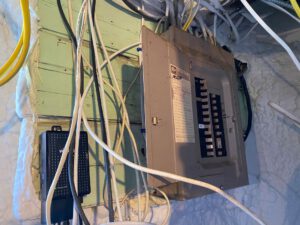Electrical repairs are best left to. Failing to do so puts your home or business at risk of structural fires and other hazards.

If your outlets are faulty, hot to the touch, or ungrounded, you should contact a licensed electrician right away. You should also get regular inspections.
Many electrical wiring problems are caused by faulty or damaged wires. This is an area that should always be inspected by a professional, as it can cause serious safety concerns and possibly fires if left unchecked for too long.
Damaged conductors, or wires, can occur for a variety of reasons, including age and exposure to the elements. They can also be nicked, pinched, or pierced by nails or screws. Regardless of the cause, any bare copper wire is a dangerous hazard that needs to be repaired immediately.
Generally, if a wire’s insulation has been ripped or cut open and you can see the copper strands inside, it is time to call an electrician for repairs. Electrical tape or heat-shrink tubing can be used to repair minor nicks and tears in cable sheathing, but the best option is to contact an electrician for a permanent solution.
You can also look for melted plastic or scorch marks on outlets or switches. These are clear signs that the circuit is overheating and that excess heat is being released. This can lead to a wide range of issues, from simple fuses blowing and short circuits to more severe problems such as melting walls and ceilings.
Faulty wiring is responsible for tens of thousands of house fires each year in the United States. However, the majority of these fires could be prevented with regular inspections and repairs. Even the most seemingly innocuous issue, like a burn mark on an outlet, should be checked and repaired immediately.
Other symptoms to watch for include a burning smell, a tingling sensation, or flickering lights. If you have a particular outlet or switch that seems to be constantly tripping your breaker, it may be causing an overload of the circuit and releasing excessive amounts of heat. If you hear buzzing sounds coming from your wall or drywall, this is another sign that it’s time to call an electrician. They can assess the wiring and make recommendations for repairs based on their findings. A qualified electrician will have a multimeter, which can detect faults that aren’t visible to the naked eye.
Outlets and switches
Replacing electrical outlets or switches can be a simple DIY job. However, since electricity is involved, there are some steps you need to take to ensure your safety.
The first step is to turn off the power to the outlet or switch. You can do this by locating the breaker switch that controls the circuit and flipping it to the off position. It’s also a good idea to use a voltage tester or multimeter to confirm that the current is truly off.
Next, unscrew the screw that holds the switch or receptacle in place and carefully remove it from the wall. If there are wires attached, note where they connect to the terminal screws and label them with some sort of identifying mark like masking tape or duct tape. This will help you reconnect them correctly to the new receptacle or switch. Generally, black wires connect to brass screws and white wires to silver ones.
It’s important to make sure the switch or receptacle is completely dry before you touch it, so you don’t get shocked. Next, remove the cover plate and carefully loosen the screws that hold the terminals and wires. Be careful not to pull too hard, which could cause the wires to break. Once the receptacle is removed, check that no current is flowing through it by touching the tester probes to each pair of terminal screws.
If there is still current, you may need to use a pair of needle-nose pliers to bend the end of each wire into a hook or “U” shape and then fit it over the terminal screw. Then tighten the screw with a screwdriver. It is a good idea to wrap the screw head and the exposed bare wire with a layer of electrical tape for added protection.
If you see arcing or sparks when you plug in something, it’s a sign of a problem and should be repaired immediately. Loose outlets can move around inside the box and create heat, which is a fire hazard. You can fix this by using a special spacer available at most home centers and hardware stores or by adding small washers under the screws to provide more support. If the box is recessed behind combustible materials, you should consider having it replaced entirely.
Other Components
While many homeowners understandably focus on the cost of labor associated with electrical repair projects, it is important to keep in mind that materials are also a big factor when it comes to electrical work. This is especially true if the project in question requires the purchase of lots of parts or other expensive components.
For example, an electrical service panel or circuit breaker that must be replaced is often quite costly. This is because the replacement of these components typically requires a substantial amount of material and can be a time-consuming undertaking. Additionally, replacing an electrical panel or breaker usually involves rewiring the entire home to ensure that all devices can be properly accommodated.
Other electrical issues are more affordable to fix. For example, if you’re experiencing frequent light bulb failures, it may be as simple as using bulbs that are too high in wattage for your lighting fixture.
In this case, an electrician can easily swap out your lights for a more appropriate and economical option.
When dealing with PCBs (printed circuit boards), it’s always a good idea to follow the proper safety protocols. This includes wearing safety glasses whenever working on the board and ensuring that the board is completely unplugged and discharged prior to soldering. Additionally, it’s a good idea to reduce contamination by washing your hands and handling only the edges of the board as opposed to the middle. Contamination introduced during the repair process can result in problems like corrosion or dendritic growth that lead to poor solderability.
If your electricity seems to be going on and off frequently or you’re getting shocked when you switch switches, plug things in, or turn lights on and off, it could be a sign that there is a serious issue with your wiring. This is a potentially dangerous problem that needs to be addressed immediately by an experienced electrical professional.
24/7 emergency service
When problems arise, you don’t want to have to wait for normal business hours to have them repaired. A licensed electrician that offers 24/7 emergency services will have the flexibility to come to your home or workplace and resolve electrical issues as quickly as possible. This will help to keep your home or office safe, comfortable, and running smoothly.
For example, if your lights are flickering on and off, this is often a sign of loose or frayed wiring that requires an emergency electrical repair. This could involve tightening the wires or, in extreme cases, executing a full rewiring job. In either case, it’s important to get the issue addressed as soon as possible to prevent further damage or fire hazards.
Another common household electrical problem is a light bulb that constantly burns out. This is usually caused by using a bulb with a higher wattage than the fixture can handle. An electrician can inspect the fixture and wiring to determine what is causing your bulbs to burn out frequently and recommend a proper household electrical repair.
Any type of electrical issue can be dangerous and should always be left to a professional. Attempting to make any emergency repairs on your own can lead to further damage, fire hazards, or even electrical shock. By hiring a licensed electrician to perform your emergency electrical repairs, you can rest assured that the job will be done correctly and safely.
